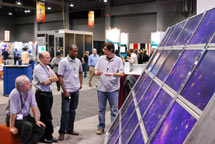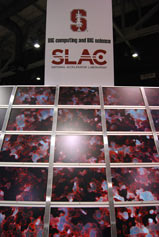
Handy Links
SLAC News Center
SLAC Today
- Subscribe
- Archives: Feb 2006-May 20, 2011
- Archives: May 23, 2011 and later
- Submit Feedback or Story Ideas
- About SLAC Today
SLAC News
Lab News
- Interactions
- Lightsources.org
- ILC NewsLine
- Int'l Science Grid This Week
- Fermilab Today
- Berkeley Lab News
- @brookhaven TODAY
- DOE Pulse
- CERN Courier
- DESY inForm
- US / LHC
SLAC Links
- Emergency
- Safety
- Policy Repository
- Site Entry Form

- Site Maps
- M & O Review
- Computing Status & Calendar
- SLAC Colloquium
- SLACspeak
- SLACspace
- SLAC Logo
- Café Menu
- Flea Market
- Web E-mail
- Marguerite Shuttle
- Discount Commuter Passes
-
Award Reporting Form
- SPIRES
- SciDoc
- Activity Groups
- Library
Stanford
Around the Bay
Supercomputing '08
|
Randy Melen, Tofigh Azemoon, Yemi Adesanya and Ralf Kaehler in front of SLAC's SC08 display. (Photo courtesy of Alf Wachsmann.
Click for larger image.)
This week, SLAC National Accelerator Laboratory exhibits its best in research aided by high performance computing at the International Conference for High Performance Computing, Networking, Storage and Analysis, also known as SC08. Hosted this year in Austin, Texas, the conference brings together scientists, engineers, researchers, educators, programmers, system administrators and managers from around the world to share the latest advances in this field. On the conference's massive exhibition floor, SLAC presenters are partnering with several groups from Stanford University to display scientific visualizations and animations. Their "screen" is a wall of 25 cinema display monitors that stretches more than 6 feet in the air. Off-the-shelf software from Apple spreads a single image or animation seamlessly across the 25 screens, automatically accounting for the empty space along the edges of the display screens. "This year, we also have a remote control that allows us to stop the animations as people ask questions," said SLAC Systems Software Developer Yemi Adesanya. "We can start, stop, change the speed and run the animations backwards. In the future, we hope to extend the remote controls to provide a more interactive visualization experience." The SLAC/Stanford exhibit also includes a 3-D projection system. This state-of-the-art system displays stereoscopic animations prepared by researchers in SLAC's Advanced Computations Department and the Kavli Institute for Particle Astrophysics and Cosmology. SLAC's Fermi Gamma-ray Space Telescope and Scientific Databases groups are also prominently featured on two large high-definition screens. "The event is going extremely well," said Alf Wachsmann of SLAC's Scientific Computing and Computing Services Group. "Many thanks to those who made this display possible, everyone from the Mechanical Fabrication Department's Welding shop to everybody in Scientific Computing Computer Services, to Stanford's Phil Reese, who headed the SC08 effort this year." —Kelen Tuttle |

